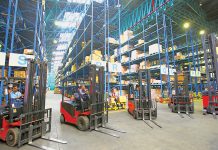Stress on developing India into a global manufacturing hub has led to expansion of storage clusters outside of tier I and II cities. Demand for A Grade warehouses in tier II and III cities has increased. It has made many firms relocate to these areas to serve rural customers, says Alexandre Amine Soufiani, Managing Director, FM Logistic India.
Bryan
What, according to you, are the major growth drivers for the logistics industry?
Supply chain management systems must adapt, evolve, and produce products and services that are not only of high quality, but also efficient, accurate, and sustainable due to changing customer demands and stiff competition. This transformation is being pushed by the pandemic’s widespread effects, increasing the need for end-to-end supply chain management (SCM) systems. These systems are smooth, technology-driven, and enhance current connections, while enhancing company performance. Businesses may streamline SCM procedures, expand their capabilities, offer end-to-end visibility, and reduce risks thanks to recent tech advancements. Every important link in the SCM process has been optimized via widespread migration from legacy systems and digitization. Ability of businesses to harness technology is crucial in setting new drivers for an efficient SCM.
Circular supply chain: A supply chain is typically thought of as being linear, beginning with raw materials, moving through production, and ending with the finished product. But as the emphasis on reuse and recycling has grown in an effort to reduce waste, intermediate scraps are now being incorporated back into the manufacturing process, making SCM circular. Such micro-economies connect producers and consumers to make it easier to use waste products, recycle them, and so lessen their impact on the environment.
Green SCM: Businesses must now include environmental sustainability into their regular supply chain procedures due to the rise of green consumerism. A recent Neilson study found that 91 per cent of consumers in the 21 to 34 year old age range are prepared to pay more for sustainable items, suggesting that people are becoming more aware of green activities.
SCM as a service: The practice of providing support in all or more is in the following areas, sourcing, production, manufacturing, quality control, warehousing, and logistics, is known as supply chain as a service (SCaaS). By concentrating on and optimizing each SCM component, the firms are able to maximize production and have a stronger effect.
Internet of Things: The Internet of Things (IoT), essential to SCM, will assist in fusing the physical and digital worlds. The IoT can turn each part of your supply chain into a ‘Smart Entity’ by attaching sensors to real objects. To cite an example, you may link a variety of IoT devices with fleet tracking, warehouse management, inventory control, and maintenance to give you a data mine for the present and the future.
Digitization: By converting to digital media, one can keep one’s supply chain flexible, dynamic, and well-organized. To make the SCM future-secure, while offering richer customer experiences, agility, and resilience in market volatility, effective digitalisation will require seamless integration of your organization’s needs with the appropriate technology tool.
Automation: Automation is essential in streamlining repetitive Supply Chain tasks because speed and accuracy are what drive today’s competitive environment. In contrast, AI’s scope would include labor-intensive, time-consuming, high-precision processes that mimic human capabilities, while ensuring mechanical precision.
Elastic SCM models: The elastic supply chain model, which adapts to the choppy market and shifting consumer dynamics, is one of the most obvious supply chain trends. Elastic supply chain techniques can be scaled up or down in scope for a specific time period to meet consumer demand at that given time.
End-to-end visibility: Greater transparency at each point in the supply chain system reduces the potential for errors, while also providing the ideal path for improvement, whether it be of the entire process or a particular sub-process. Greater responsiveness, quicker responses, and quicker access to the system are all made possible by increased visibility.
Customization: Today’s consumer wants a tailored experience that meets or even exceeds their expectations for a good or service. Customization, which permits a tailored approach of individual supply chain connections to suit a specific or broad consumer segment, is riding the supply chain trend. Consider additional packaging for orders that are delicate and fragile.
Risk management: Market uncertainty is a significant issue that demands readiness from the supply chain process. The system in place should be able to anticipate any dangers or threats in the future and effectively respond to dangers, threats and volatility in the market.
How do govt initiatives such as PM GatiShakti and Make in India among many others help in better opportunities and projections?
The Indian warehousing industry is suffering from the effects of COVID just like other industries. Logistics and warehouse space absorption will bounce back from COVID’s ill-effects rapidly, driven by booming expansion in the manufacturing and e-commerce sectors and increased demand in emerging tier II and III cities. The likely causes of this expansion are a rise in organized retail and an increase in demand for temperature-controlled warehouses to store perishables, FMCG and pharmaceutical products. There is hope because the logistics industry has recovered the fastest ever since the COVID cases have reduced. Demand for warehousing is on the rise, and the pharmaceutical and e-commerce industries are major growth drivers.
We continue to strengthen our portfolio of end-to-end supply chain services to establish ourselves as the reference partner in India for sustainable omnichannel supply chains. Our efforts are concentrated on creating Grade A multi-client facilities (MCFs), specialized warehouses close to our customers’ manufacturing facilities, and cutting-edge urban logistic hubs connected by a flexible last mile delivery (LMD) network. We keep enhancing our value-added services such as co-packing, automated labeling, and customization for preparedness of the digital marketplace. The Union government’s ‘Make In India’ initiative will keep the logistics sector growing. Several variables will contribute to the future growth of the warehousing industry. They are projected to cause it to
grow significantly.
What are the major bottlenecks faced by the industry?
Despite rising demand, India’s logistics industry is facing many issues —cost pressures, excessive returns, and subpar infrastructure. The major hurdles will be managing returns and collecting payments. Insufficient integration of transportation networks, IT, and storage and distribution facilities is another problem. Distribution network is effective and well-connected at FM Logistic India. Our extensive transportation network spans 20 branches across India and over 100 specialised vehicles. Industrial and retail units require trained labour. There is a shortage of qualified management and customer service staff due to the structure of the Indian logistics business, the notion is a manpower-intensive sector, and the absence of suitable training schools. The Supervisor Development Program, which FM Logistic India has introduced at the warehouse level, allows warehouse workers to advance to the position of Team Leader.














